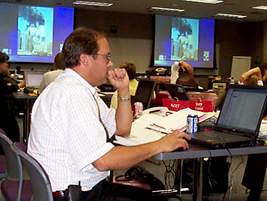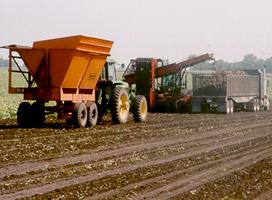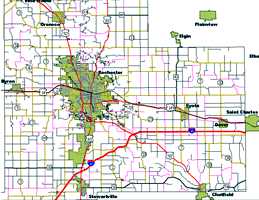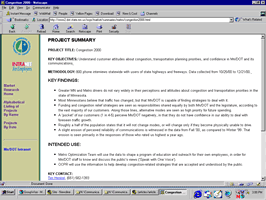 |
 |







|
 |
 |
 |
 |
 |
 |
 moving minnesota through employee communication moving minnesota through employee communication |
 |
 |
 September
12, 2001 September
12, 2001 |
No. 30 |
 |
|
|
 |
 |
 |
Commissioner, staff in D.C. day of terrorist attack
|
 |
 |
 |
|
In the heart of the
state’s Emergency Operations Center, Bob Vasek, Mn/DOT’s emergency management
coordinator, keeps tabs on incoming messages as a live feed from CNN displays
the World Trade Center's twin towers in the background. Several other
Mn/DOT employees volunteered to staff the hotline phones Tuesday and Wednesday.The
SEOC and the hotline closed at 7:00 p.m. Wednesday. Calls to the hotline
will go to the state duty officer. Vasek and Kent Barnard, Mn/DOT’s communications
liaison, will remain on call through the weekend. Photo by Kent Barnard
|
A phone call from Commissioner Elwyn Tinklenberg, who was in Washington, D.C.,
Sept. 11 when the Pentagon was attacked by terrorists, assured staff in St.
Paul that he and members of his group were okay. They were two miles away from
the military complex when it was hit Tuesday morning by a hijacked airliner
with 64 people aboard.
"The past two days have been filled with immense emotion for all of us,"
the commissioner said from his hotel room. "All across the nation we have
been united in grief and anger unparalleled in our history. I appreciate all
Mn/DOT employees for persevering throughout this time to keep the department
operating.
"Our prayers go out to the victims of this senseless tragedy and to their
families."
Accompanied by Chief of Staff Margo LaBau and Director of Federal Affairs Dan
Krom, the commissioner had testified before a U.S. Senate subcommittee on Monday.
(See article below.) He was scheduled to meet with Minnesota's congressional
delegation on Capitol Hill on Tuesday, but that meeting was canceled and the
area evacuated because of additional threats on the nation’s capital.
The three had been scheduled to return to the Twin Cities Tuesday evening.
All air travel in the U.S., however, had been suspended at least through Wednesday.
They are trying to find an alternative way home, the commissioner said.
|
back

|
 |
Commissioner testifies on ITS benefits before U.S. Senate subcommittee
|
 |
 |
Commissioner Elwyn Tinklenberg testified before a U.S. Senate subcommittee
on Sept. 10 about using technology to move the nation into the 21st century.
Representing the American Association of State Highway and Transportation Officials
before the Senate Subcommittee on Transportation, Infrastructure and Nuclear
Safety, Tinklenberg spoke of the many benefits technology brings on a national
and local level. He acknowledged the vision and foresight of committee members
for including intelligent transportation systems as a key component of federal
highway and transit programs.
Tinklenberg, who chairs AASHTO’s Advanced Transportation Systems Subcommittee,
spoke specifically about the work in Minnesota.
"ITS technologies have already proven their effectiveness in improving
our operations while increasing our safety," he said. "In the Twin
Cities, adaptive signal systems combined with ramp metering have improved freeway
travel time 22 percent, reduced crashes by 24 percent and improved freeway throughput
by 14 percent. Use of our Road Weather Information System provides motorists
with real time information, and improves winter maintenance, significantly reducing
accidents on highways and bridges. A computer-aided dispatching system for emergency
vehicles is saving lives."
These and other success stories are mirrored across the nation, Tinklenberg
said. From transportation management centers to the cooperative development
of 511 traveler information deployment, ITS has fostered unique and effective
partnerships between federal, state and local agencies, industry and national
associations such as AASHTO.
In closing, the commissioner said, "In the last 10 years, ITS has turned
the corner from a vision to a reality, and has demonstrated its powerful potential
for transforming our transportation system. ITS deployments have made significant
improvements in rural, urban, transit and commercial vehicle applications. Not
only that, they have produced new partnerships never before envisioned, transferred
advanced technology from NASA and the defense industries, and enabled us to
stretch the use of our transportation system in new ways."
ITS technology is a key component of a new focus on transportation system operations,
and will be highlighted at the upcoming National Summit on Operations Oct. 16-18.
|
back

|
 |
Special permits allow growers to move crops quickly during harvest ‘rush hour’
|
 |
 |
 |
|
Sugar beets are loaded
into a truck in a producer's field in west central Minnesota. During the
fall, this seven-county area sees approximately 200,000 non-commercial
trucks hauling harvested crops from farm to market. Photo courtesy
of Southern Minnesota Beet Sugar Co-op
|
As surely as fall follows summer, the state’s sugar beet harvest turns normally
quiet stretches of western Minnesota’s rural roads into busy avenues of commerce.
The beet haul often goes around the clock as growers race to get their beets
out of the ground and into the processing plants before the ground freezes.
And the beets are not the only farm commodities moving. Potato growers, wheat
farmers and others are moving their crops to storage or to market during the
harvest season.
In order to keep the heavily laden farm trucks moving, Mn/DOT issues permits
for sugar beet and potato movers to carry heavier loads during the harvest "rush
hour" which can last for weeks.
Last year, officials in the Willmar and Detroit Lakes districts issued more
than 1,100 permits for beet and potato movers. The permit allows haulers to
carry a 10 percent weight increase over normal legal weights for first haul
only from field to first unloading site, notes Alice Janiszeski, customer service
specialist at Marshall.
Motorists are advised to use extra caution at night and during inclement weather
because of the high volume of truck traffic. They also need to be aware of slower
moving vehicles and mud or other debris on the roadway.
Because freshly harvested beets can be wet and muddy, mud often drops from
the beet trucks. Mn/DOT will remove mud at the request of area law enforcement
officials; however, Mn/DOT may bill the responsible party for cleanup service.
By Craig Wilkins
|
back

|
 |
Environmental Services, Technical Support shift staff
|
 |
 |
Mn/DOT’s offices of Environmental Services and Technical Support have implemented
some shifts in their organizational structures.
Landscape Architecture and related functions have been consolidated in Technical
Support. Previously, both offices had landscape units responsible for advising
district planners and designers on roadside plantings, rest area environments
and community entrances.
Cultural Resources, the unit responsible for review, documentation and guidance
on the historic and archeological impact of transportation projects, has moved
from Technical Support to Environmental Services.
Merritt Linzie, Environmental Services director, said the moves support the
needs of program delivery and reflect the department’s commitment to context
sensitive design and focus on interregional corridors. Dick Elasky serves as
director of Technical Support.
By Jeanne Aamodt
|
back

|
 |
Ekern, Lund to take on new roles
|
 |
 |
Dave Ekern, assistant commissioner for National and International Programs,
has accepted a mobility assignment as an associate director with the American
Association of State Highway and Transportation Officials, announced Deputy
Commissioner Doug Weiszhaar. His appointment is effective Sept. 17.
Ekern has been central to coordinating Mn/DOT's national initiatives with AASHTO
and the Transportation Research Board, according to Weiszhaar.
"We are all excited about this opportunity and new agreement, and believe
that the transportation industry in Minnesota and the nation will be well-served
by the contributions Dave will bring to this assignment," he said.
Steve Lund was named as area maintenance engineer at Rochester. Before his
appointment, Lund served as the Metro Division maintenance operations engineer.
Lund’s appointment becomes effective Sept. 24. He succeeds Bernie Arseneau who
was appointed as assistant district engineer for contract delivery.
Lund will join a restructured Rochester District management team. The team
comprises Nelrae Succio, district engineer; Tony Hames, ADE for program delivery;
Gary Bruggeman, Owatonna area maintenance engineer; Greg Paulson, assistant
district engineer for state aid and bridges; Judy Schmidt, district administrative
manager, Arseneau and Lund.
|
back

|
 |
Enhanced Mn/DOT BaseMap information now available online
|
 |
 |
 |
|
The GIS BaseMap includes
information about roads, railroads, navigable waters, district boundaries,
civil townships, state and national forests and parks, and Indian reservation
lands.
|
Where can you go to see the routes for all roads in a specific county, not
just the trunk highways? How do you know which cities, townships, or roads are
in your project area?
You can answer questions like these and others by using information from the
new, enhanced BaseMap, now available on the Web at http://rocky.dot.state.mn.us/BaseMap.
The Mn/DOT BaseMap is a set of transportation and transportation-related data
developed specifically for use in a Geographic Information System. The BaseMap
is a single source of information for Mn/DOT practitioners as well as other
state, local and private partners who worked cooperatively with Mn/DOT to develop
the data, said Denny Brott, GIS supervisor, Land Management.
"Trunk highways are just a part of a larger, interconnecting system of
roads," Brott said. "Information about the entire system, all in one
location, is invaluable to all the different jurisdictions and agencies that
have to manage those roads separately and in cooperation with each other."
BaseMap includes information about roads, railroads, navigable waters, district
boundaries, civil townships, state and national forests and parks, and Indian
reservation lands. This information can help planners, designers and project
managers do crash mapping, pavement forecasting, asset inventories, traffic
flows and collect rail crossing fatality information, according to Dan Ross,
GIS project manager, Business Operations.
"In the past, BaseMap data was only available to external users on CD
once a year," Ross said. "Updates to the data can now be posted as
they occur and accessed immediately."
Road information is available county-by-county and includes roadway names.
Related information is available at a statewide level. Currently, 18 of the
county road files have routes built on them; all other county road files are
available as line-work. As further county routes are completed, they will be
posted. Check the Web site periodically for updates.
For more information about the BaseMap
Web site or how to access BaseMap data, contact Dan Ross at 651/282-6113
or Denny Brott at 651/296-1680.
By Donna Lindberg
|
back

|
 |
New on the Web: Summaries of market research studies at your fingertips
|
 |
 |
 |
The Congestion 2000
market research study is just one of more than 50 studies summarized into
one page and posted on Mn/DOT's internal Web site.
|
What do noise walls, mural art, HOV lanes, rest areas, bright signs and pavement
markings have in common? They have all been the subjects of Mn/DOT market research
with the department’s external customers.
Summaries from these and more than 50 other studies are now available on Mn/DOT’s
intranet site.
The summaries offer one-page snapshots—including information about the objectives,
key findings, methodology and intended use—for each study.
"These pages represent the work of more than seven years of Mn/DOT market
research," notes Chris McMahon, Market Research. "The individual studies,
together with the customer segmentation study conducted in 2000, give us a big
base of knowledge about who our customers are and how they value Mn/DOT products
and services."
Check out the summaries at http://www2.dot.state.mn.us/ocpr/market/topics.html.
Learn more about the staff and products and services of the Mn/DOT market research
section at: http://www2.dot.state.mn.us/ocpr/team/market.html.
By Kay Korsgaard
|
back

|
 |
Maryland truck station crew receives thanks
|
 |
 |
Editor’s note: On July 12, a truck traveling westbound on I-694 at I-35E
lost a load of granite on the road. Large chunks of rock covered about 150 feet
of the left and right lanes, and the guardrail sustained extensive damage as
a result of the granite sliding across the road and striking the posts.
Jim Michael, maintenance superintendent for Metro Division's central region,
received this letter, which reads, in part:
…. Within a few minutes there were several maintenance employees from the Maryland
shop along with a front-end loader on scene. The purpose of my letter is to
inform you that the Maryland shop workers did an extraordinary job of quickly
responding and cleaning up the road. Not only did they quickly respond and get
to work but they did so in an area that they do not usually cover. I, along
with the troopers who were on the scene with me, greatly appreciated the efforts
that were put forth to reopen the interstate as quickly as possible.
--Trooper Matt Langer, State Patrol
|
back

|
|
 |
|
|


